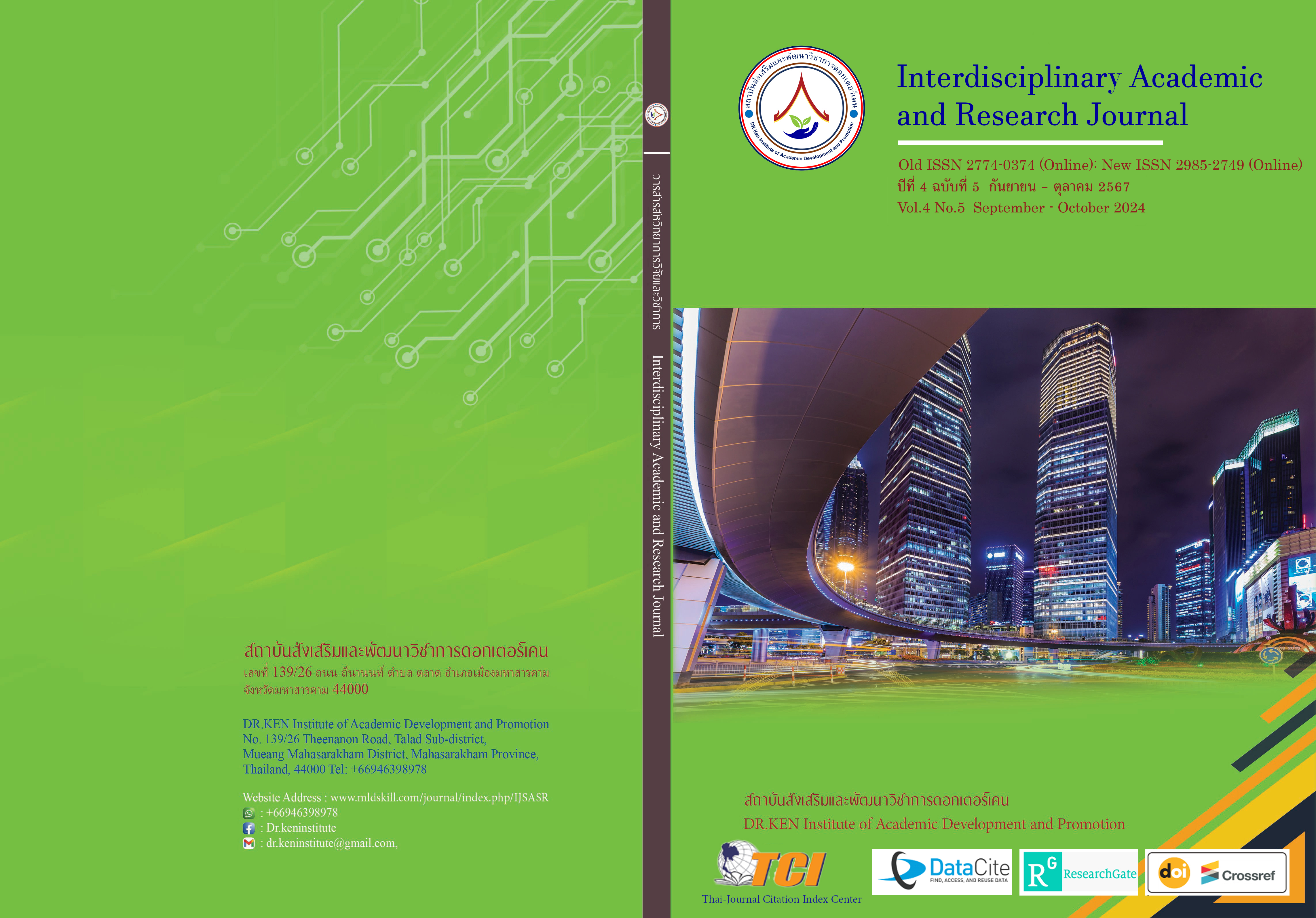The Development Model of Educational Management for Special Classrooms of School Under The Secondary Educational Service Area Office Kalasin
DOI:
https://doi.org/10.60027/iarj.2024.277903Keywords:
Development Model;, Special Classroom Education Management;, SchoolsAbstract
Background and Aims: The creation of special classes aimed at helping students with exceptional abilities in academics and other areas reach their full potential, according to the guidelines set forth by the Ministry of Education regarding the decentralization of management and administration of education to the educational Service area office by giving schools the chance to set up special classrooms if they have the staff and finances to do so. According to projects started by the Basic Education Commission, special classrooms are spaces where educational institutions concentrate on teaching and learning activities meant to promote the potential of students with extraordinary abilities. Therefore, the objective of this research is to 1) study the components and indicators of educational management for special classrooms of schools. 2) to study the current situation, desirable condition and needs assessment of educational management for special classrooms of school under the secondary education service area office Kalasin. 3) to create a model for educational management for special classrooms of schools under the secondary education service area office Kalasin.
Methodology: The research was divided into 4 phases: Phase 1 studied components and indicators of educational management for special classrooms of the school, the key informant group was 7 experts, and the research tool was an interview form. Phase 1 studied the current situation, desirable condition, and needs assessment of educational management for special classrooms of school, the sample group consisted of 358 people, research tool was a questionnaire with a reliability of .79. Data were analyzed by means and standard deviation. Phase 3 created a model for educational management for special classrooms school, The key informant group was 9 experts to create and evaluate the suitability Feasibility, and usefulness of the model and the evaluating group the manual for using the model was 15 people. The research tool was an interview form evaluation form, data were analyzed by means and standard deviation
Results: 1. The components and indicators of educational management for special classrooms of school consisted of 1) management, 2) curriculum and academics, 3) environment that promotes learning, 4) personnel and budget, and 5) learner quality. 2. The overall current condition is at a high average level. The overall desirable condition was at the highest mean level. The necessary needs index was ranked from the highest to the lowest as follows: 1) curriculum and academics, 2) personnel and budget, 3) environment that promotes learning, 4) quality of learners, and 5) management. Respectively. 3. The model consists of components: 1) principles, 2) objectives, 3) content, 4) development process, and 5) measurement and evaluation. There are 4 learning modules: Module 1, Curriculum and Academic Module 2, Personnel and Budget Module 3, Environment that Promotes Learning Module 4, Quality of Learners Module 4, and Management. The model has a suitability assessment result. The model's possibility and overall usefulness were at the highest level.
Conclusion: The management of special classrooms in schools currently faces various challenges and suggestions for improvement in several aspects including administration and research into developing management models for more effective governance. School administrators, teachers, parents, and students must all participate in the management process, collaborate in designing operational frameworks in various aspects, and identify areas that require expedited development within the project to achieve efficiency and effectiveness for the students. There are clear and coherent curricula aligned with students' development. There are various supplementary activities in different formats to enhance the curriculum. There is a learning management system that emphasizes both theory and practice, and there should be support systems in place to assist students with their needs and potential.
References
กระทรวงศึกษาธิการ. (2550). แนวทางการเป็ดห้องเรียนพิเศษในสถานศึกษาขั้นพื้นฐาน สังกัดคณะกรรมการการศึกษาขั้นพื้นฐาน. กรุงเทพฯ: ชุมนุมสหกรณ์การเกษตรแห่งประเทศไทย.
ธีระ รุญเจริญ. (2550). การบริหารโรงเรียนยุคปฏิรูปการศึกษา. กรุงเทพฯ: ธนาเพรส.
บุญชม ศรีสะอาด. (2545). การวิจัยเบื้องต้น (พิมพ์ครั้งที่ 7). กรุงเทพฯ: สุวีริยาสาส์น.
ปริยาภรณ์ ตั้งคุณานันต์. (2558). การจัดการห้องเรียนและแหล่งเรียนรู้. กรุงเทพฯ : มีน เซอร์วิสซัพพลาย.
สมาน อัศวภูมิ. (2550). “การใช้วิจัยพัฒนารูปแบบในวิทยานิพนธ์ระดับปริญญาเอก” ในเอกสารประกอบ การสอนวิชาสัมมนาการศึกษาระดับปริญญาเอก. อุบลราชธานี: มหาวิทยาลัยราชภัฏอุบลราชธานี.
สันติ บุญภิรมย์. (2556). การบริหารจัดการในห้องเรียน CLASSROOM MANAGEMENT. ยะลา : โอ.เค.คอมพิวเตอร์แอนด์ปริ้นติ้ง.
สำนักงานคณะกรรมการการศึกษาขั้นพื้นฐาน. (2559). แนวทางการเปิดห้องเรียนพิเศษ ในสถานศึกษาขั้นพื้นฐาน พ.ศ. 2559. กรุงเทพฯ : สำนักนโยบายและแผนการศึกษาขั้นพื้นฐาน สำนักงานคณะกรรมการการศึกษาขั้นพื้นฐาน กระทรวงศึกษาธิการ.
สำนักงานคณะกรรมการการศึกษาขั้นพื้นฐาน. (2563). แนวทางการนิเทศการจัดการเรียนรู้เชิงรุก (Active Learning). กรุงเทพฯ : หน่วยศึกษานิเทศก์สำนักงานคณะกรรมการการศึกษาขั้นพื้นฐาน.
สำนักงานเลขาธิการสภาการศึกษา. (2560). รายงานการวิจัยแนวทางการพัฒนาการศึกษาไทยกับการเตรียมความพรอมศตวรรษที่ 21. กรุงเทพฯ : สำนักงานเลขาธิการสภาการศึกษา.
สำนักงานเลขาธิการสภาการศึกษา. (2563). การติดตามและประเมินผลการบูรณาการองค์ความรู้แบบสะเต็มศึกษาในสถานศึกษา. กรุงเทพฯ : สำนักประเมินผลการจัดการศึกษา.
สำนักบริหารมัธยมศึกษาศึกษาตอนปลาย. (2560). การขับเคลื่อนการศึกษามัธยมศึกษาไทย 4.0 เพื่อการมี งานทำแห่งศตวรรษที่ 21. กรุงเทพฯ : โรงพิมพ์ชุมนุมสหกรณ์การเกษตรแห่งประเทศไทย จำกัด.
สิริกร ไชยราช. (2562). การพัฒนารูปแบบการพัฒนาภาวะผู้นำครูในการจัดการเรียนรู้ตามหลักปรัชญาของเศรษฐกิจพอเพียง ในโรงเรียนมัธยมศึกษา สังกัดสำนักงานศึกษาธิการภาค 11. วิทยานิพนธ์ครุศาสตรดุษฎีบัณฑิต: มหาวิทยาลัยราชภัฏสกลนคร.
สุวิมล ว่องวาณิช. (2558). การวิจัยประเมินความต้องการจำเป็น. กรุงเทพฯ : สำนักพิมพ์แห่งจุฬาลงกรณ์มหาวิทยาลัย.
Anderson, T.P. (1997). “Using Models of Instruction. In C. R. Dills and A. J. Romiszowski (eds)”. Instructional Development Paradigms. Englewood Cliffs, NJ: Educational Technology Publications.
Cronbach, L.J. (1970). Essentials of psychological testing. 3rd edition. New York: Harper & Row.
Eisner, E. (1976). Education Connoisseurship and Criticism: Their Form and Function in Education Evaluation. Journal of Aesthetic Education. 10 (4), 135-150.
Joyce, B., Weil, M., & Calhoun, E. (2011). Models of Teaching. Boston MA: Pearson Education, Inc.
Maker, C., June, N., &Aleene, B. (1995). Teaching Models in Education of the Gifted. 2nd edition, Texas: PRO-ED.
Downloads
Published
How to Cite
Issue
Section
License
Copyright (c) 2024 Interdisciplinary Academic and Research Journal

This work is licensed under a Creative Commons Attribution-NonCommercial-NoDerivatives 4.0 International License.
Copyright on any article in the Interdisciplinary Academic and Research Journal is retained by the author(s) under the under the Creative Commons Attribution-NonCommercial-NoDerivatives 4.0 International License. Permission to use text, content, images, etc. of publication. Any user to read, download, copy, distribute, print, search, or link to the full texts of articles, crawl them for indexing, pass them as data to software, or use them for any other lawful purpose. But do not use it for commercial use or with the intent to benefit any business.
















.png)


